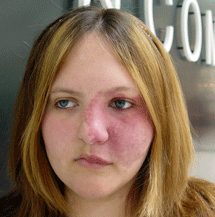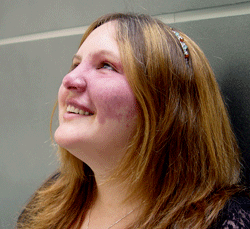 |
THE STAIN
FINDING THE GRACE OF GOD IN THE
MIDST OF DIFFICULTY
By Rhonda Hodges
Photos: Eric K. Thomsen |
SHE'S HERE! SHE'S FINALLY HERE!
As the doctor hands my daughter to me for the first time, I am filled with emotion. I count her fingers and toes, and I count my blessings. She is a gift from God, and she is beautiful! As I smile groggily, my attention is drawn to the color of her face. Something seems unusual, but I am too tired to figure it out. As her daddy passes her to the nurse to be weighed, measured, and cleaned up, He also notices something unusual.
A pediatrician bluntly explains that Crystal has a port-wine stain (vascular birthmark) covering the left side of her face. As the name suggests, the birthmark is deep red, almost purple in color. We bombard him with questions: Will it go away? Are there side affects? What caused it? Did I do something wrong during my pregnancy?
We soon learned that 10% of all babies are born with a port wine stain birthmark (although only a small percentage of these are located on the face). This type of birthmark is formed by extra blood vessels under the skin and will not go away on its own. The birthmark often darkens as the person ages. Laser treatments will lighten the stain, but they are not always effective.

This type of birthmark runs beneath the skin. A severe stain like Crystal’s can reach deep into the brain. Doctors warned us that she could suffer a traumatic seizure during the 24 hours following her birth that would cause lasting brain damage. We breathed a deep sigh of relief when 24 hours passed with no sign of a seizure.
The causes of this particular birth defect are unknown. The documented fact that port wine stains are not caused by the actions of an expectant mother does not relieve the nagging guilt, the question, “Did I do this to my child?” It took years for me to gradually accept my innocence.
Reality Check
As the reality of Crystal’s condition set in, I began to wonder how society would accept my child. The question was answered on her first trip to church, only a few days after her birth. As we passed by, an elderly man leaned over and whispered to his wife, “Did you see her face?” His audible whisper was much louder than he realized, and I overheard the stinging remark.
Several weeks later, during a family shopping trip, my sister Felicia was holding the baby when a man casually asked, “How did you burn your baby?” This is the most offensive, brutal comment I remember. How could anyone ask a complete stranger such a personal and horrifying question? When he looked at our marvelous gift from God, he only saw her stain.
On another occasion, as my sister Joanna held Crystal, a lady appeared from nowhere. “What’s wrong with your baby?” She asked harshly. Taken aback, Joanna told the offensive women it was only a birthmark. She could hardly resist asking what was wrong with her, to ask such a rude and thoughtless question.
As one might expect, our family has always tried to protect Crystal from cruel and thoughtless questions and comments. I did not realize how much these remarks bothered her older sister Amanda until the day she caught a clerk at the local hardware store staring intently at the stain. Amanda blurted, “It’s a birthmark—only a birthmark!” Later, she told me that she was tired of people staring at her sister because she looked different.
Rising to the Challenge
We tried many different types of laser treatment to lighten the stain. We stopped counting after Crystal’s 14th surgery. While the surgeries lightened the birthmark, they did not remove it. Each painful surgery leaves the skin discolored, swollen, and bruised. It takes several weeks before the stain gradually begins to lighten. Since Crystal has gotten older, surgery has become less effective. As technology improves, however, we hope new procedures will make her stain substantially lighter.
Of more concern was the effect on Crystal’s eyesight. Because the birthmark covers her eye, doctors were deeply concerned. Their fears were realized when Crystal was diagnosed with glaucoma at age nine. Yet, her loss of vision has made her intent on seeing what’s really important—the inner worth of a person rather than his or her outward appearance.
Staring Contests
When the world looks at Crystal, it can’t see beyond the visible stain that cannot be hidden and rarely takes time to get to know the beautiful person behind the stain. And so, the stares continue.
When Crystal realizes someone is staring, we lighten the moment by staring back—an impromptu “contest.” Without fail, the person turns away in embarrassment. While I try to laugh to myself, I still become angry. After nearly 16 years, I still want to protect my beautiful daughter from thoughtless, hurtful words and actions.
Surprisingly, adults are the most inconsiderate. Children simply look at Crystal for a minute before resuming their activities. When a child asks about her face and she tells them her stain is a birthmark, their curiosity is usually satisfied. Often, they show her their own birthmarks. Life continues for them as if nothing is unusual. No wonder Jesus said a child-like spirit represents the Kingdom of Heaven!
Behind the Stain
Crystal’s friends and family no longer see Crystal’s birthmark. They see Crystal. They have discovered the person behind the stain—the fun, dramatic, delightful girl who loves to be the center of attention! They forget her condition until we request prayer for an upcoming surgery. Often they must be reminded why she is having the surgery.
As her mother, I can’t even remember which side of her face the birthmark affects. When scheduling a doctor’s appointment, I have to look at her picture to remember where it is located.
 Crippled Vision Crippled Vision
I criticize others for failing to accept my daughter as she is, but too often, the same is true of me. We are sadly human, judging others by their looks rather than their personality or intrinsic qualities. This natural prejudice goes far beyond birthmarks or defects.
Consider those who are too heavy. We typically think they are lazy and listless. On the other hand, we assume that those who are very thin are sick or have an eating disorder. I can almost hear the sarcastic speculation. “How else could they stay that skinny?” What about those with severe acne? We assume their hygiene is not what it should be. We forget that medicine or overactive glands might cause their condition.
How often have we missed a wonderful friendship because our “crippled vision” caused us to judge another by his looks?
Two young ladies in our church are mentally challenged. One has Down’s syndrome, the other mental disabilities. For years, I avoided these girls because they were “different”. Today, my attitude has changed dramatically. Maybe it's because my own daughter’s stain has taught me to look beyond the surface. Maybe I’ve simply matured. In either case, I have learned a tremendous lesson. If we judge people by the way they look, we limit their abilities and—even more serious—question God’s ability to work through them.
In 2004, Crystal started a pen pal ministry to missionaries and their families. The global ministry has been featured on talk shows and radio stations across the country—amazing for a pre-teen. In 2005, she was named Free Will Baptist Youth of the Year. As God continues to work through her, I find myself asking time and again. Stained? Absolutely! Stained with the power of God grace!
Rhonda Hodges and her family live in Fresno, CA.
|

